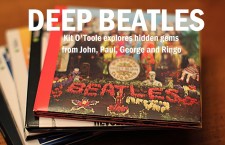Frustratingly few sources exist that present a clear picture of how the early Beatles sounded live. The Star Club tapes and both volumes of Live at the BBC allow listeners a glimpse of how they sounded in Hamburg and Liverpool. However, their first two albums, Please Please Me and With the Beatles, simulate their rambunctious live shows to some degree.
With the Beatles, in particular, emits a spontaneous sound – a feeling that the group is playing in the same room as the listener. One With the Beatles deep track that would have been a stomping number live is “Little Child,” a rocker that surely would have riled up audiences at the Cavern.
Originally intended for Ringo Starr, “Little Child” draws from three inspirations. As Paul McCartney told Barry Miles in Many Years from Now, he and John Lennon composed the track specifically to suit Starr’s more limited singing abilities. “He didn’t have a large vocal range but he could handle things with good con brio and spirito, if they were nice and simple,” McCartney said. He dubbed “Little Child” a “work job,” meaning “certain songs were inspirational and you just followed that. Certain other songs were ‘Right, come on, two hours, song for Ringo for the album’.”
Lennon and McCartney borrowed from two British musicians: Elton Hayes and Cyril Davies. A folk singer and actor, Hayes became a familiar presence on 1950s radio and TV, earning the nickname “the man with the small guitar.” In 1952, Hayes played minstrel Alan-a-Dale in the Disney film The Story of Robin Hood and His Merrie Men, during which he performed the tender ballad “Whistle, My Love.” McCartney later admitted that he based “Little Child’s” melody (particularly on the “I’m so sad and lonely” lyric) on “Whistle, My Love,” although the tunes are not identical.
In addition, Lennon’s raucous harmonica owes a debt to Cyril Davies, one of England’s first (and best) blues harmonica players. Davies began his career as a jazz guitar and banjo player; after hearing Little Walter, he changed to the blues harmonica. By 1961, Davies helped found the group Blues Incorporated, and they attracted fans such as Mick Jagger and Eric Burdon through their intense club performances. Just a year later, Davies departed the band to form his own act, the Cyril Davies All-Stars; they subsequently recorded “Country Line Special,” widely considered the first British blues single.
Another Davies track, “Chicago Calling,” inspired future British Invasion legends Ray Davies and Pete Townshend. Years later, Townshend stated that “Chicago Calling” inspired him to ask another All-Stars member, Nicky Hopkins, to play on the Who’s first album. (Hopkins would go on to guest on Beatles tracks, as well.)
The Beatles were also fans of Davies and his All-Stars; the band would guest star on the Beatles’ Pop Go the Beatles radio series on August 1, 1963. Sadly, Davies’ career ended too soon, as he died from pleurisy on January 7, 1964. However, his gritty, uninhibited harmonica style clearly influenced John Lennon, as the “Little Child” solo bears some resemblance to Davies’ technique on “Country Line Special.”
When they arrived at Abbey Road Studios to record “Little Child,” one major change had occurred: for some reason, Rigo Starr declined to sing lead on the track. Thus, Lennon and McCartney assumed lead vocals; the complete lineup includes Lennon on rhythm guitar and harmonica, McCartney on bass and piano, George Harrison on guitar, and Starr on drums.
They completed two takes on September 11, 1963; the next day, they laid down an additional 16 takes, including overdubs of piano and harmonica. Despite this long session, the Beatles remained unhappy with the work; they finally completed three more takes on October 3 (Lennon and McCartney also added their vocals).
The lyrics typify pop of that time, telling the story of a man trying to woo a woman. He begs her to dance with him, playing on her sympathies with the line “I’m so sad and lonely.” Lennon and McCartney harmonize on the line, almost cooing; their voices slightly drop on the phrase “baby take a chance with me,” sounding much more confident and aggressive. The seduction continues as Lennon and McCartney croon in the same key, their voices intertwining to the point where they meld into one. “If you want someone to make you feel so fine / Then we’ll have some fun when you’re mine, all mine,” the duo sings, and the sexual innuendo is unmistakable.
Lennon’s harmonica enhances the sexual energy with its raw quality, with the solo abruptly ending to introduce the final verse. The screaming at the beginning of the instrumental break recreates the Beatles’ live show, both encouraging the other musicians and exciting the audience. It’s a technique they used frequently, as evidenced by the Star Club performances and on previous recordings such as “Twist and Shout.”
The Beatles never performed “Little Child” live or released it as a single, but the song still holds merit. “Little Child” may not break new ground lyrically or structurally. However, it paints a tantalizing picture of the organic sound of the Beatles, giving a taste of their early years in dingy clubs. The track riles up the crowd with its thundering drums and bass, Lennon’s harp, and Lennon and McCartney’s enthusiastic singing performance. For a slice of pure R&B and rock, look no further than “Little Child.”
- How John Lennon Came Roaring Back on the Beatles’ White Album - November 22, 2023
- Five ‘With the Beatles’ Deep Cuts That Illustrate Their Lasting Debt to R&B - November 20, 2023
- Five Must-Hear Deep Cuts from the Beatles’ ‘Past Masters’ - March 7, 2023


